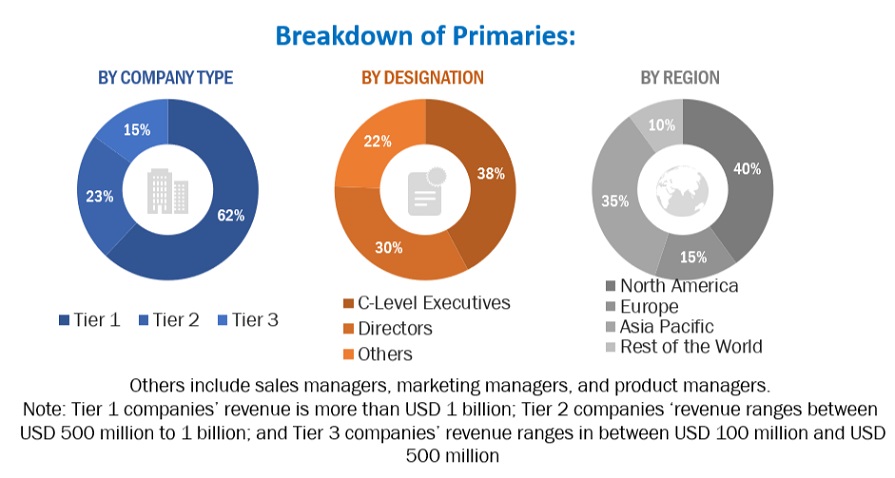This research study involved the extensive use of secondary sources, directories, and databases, such as Dun & Bradstreet (D&B) Hoovers and Bloomberg BusinessWeek, to identify and collect information useful for a technical, market-oriented, and commercial study of the autonomous networks market. The primary sources have been mainly industry experts from the core and related industries and preferred suppliers, manufacturers, distributors, service providers, technology developers, alliances, and organizations related to all segments of the value chain of this market. In-depth interviews have been conducted with various primary respondents, including key industry participants, subject matter experts, C-level executives of key market players, and industry consultants to obtain and verify critical qualitative and quantitative information.
Secondary Research
The market for companies offering autonomous networks solutions and services to different verticals has been estimated and projected based on the secondary data made available through paid and unpaid sources, as well as by analyzing their product portfolios in the ecosystem of the autonomous networks market. It also involved rating company products based on their performance and quality. In the secondary research process, various sources such as Autonomous Networks Summit 2024, and Network Automation Congress 2023 have been referred to for identifying and collecting information for this study on the autonomous networks market. The secondary sources included annual reports, press releases investor presentations of companies, white papers, journals, and certified publications and articles by recognized authors, directories, and databases. Secondary research has been mainly used to obtain key information about the supply chain of the market, the total pool of key players, market classification, segmentation according to industry trends to the bottommost level, regional markets, and key developments from both market- and technology-oriented perspectives that have been further validated by primary sources.
Primary Research
In the primary research process, various primary sources from both the supply and demand sides were interviewed to obtain qualitative and quantitative information on the market. The primary sources from the supply side included various industry experts, including Chief Experience Officers (CXOs); Vice Presidents (VPs); directors from business development, marketing, and product development/innovation teams; related key executives from autonomous networks solution vendors, SIs, professional service providers, and industry associations; and key opinion leaders. Primary interviews were conducted to gather insights, such as market statistics, revenue data collected from solutions and services, market breakups, market size estimations, market forecasts, and data triangulation. Primary research also helped understand various trends related to technologies, applications, deployments, and regions. Stakeholders from the demand side, such as Chief Information Officers (CIOs), Chief Technology Officers (CTOs), Chief Strategy Officers (CSOs), and end users using autonomous networks solutions, were interviewed to understand the buyer’s perspective on suppliers, products, service providers, and their current usage of autonomous networks solutions which would impact the overall autonomous networks market.

To know about the assumptions considered for the study, download the pdf brochure
Market Size Estimation
Multiple approaches were adopted to estimate and forecast the size of the autonomous networks market. The first approach involves estimating market size by summing up the revenue generated by companies through the sale of autonomous networks offerings.
Both top-down and bottom-up approaches were used to estimate and validate the total size of the autonomous networks market. These methods were extensively used to estimate the size of various segments in the market. The research methodology used to estimate the market size includes the following:
-
Key players in the market have been identified through extensive secondary research.
-
In terms of value, the industry’s supply chain and market size have been determined through primary and secondary research processes.
-
All percentage shares, splits, and breakups have been determined using secondary sources and verified through primary sources.
Autonomous Networks Market Size: Bottom-Up Approach

To know about the assumptions considered for the study, Request for Free Sample Report
Autonomous Networks Market Size: Top-Down Approach

Data Triangulation
After arriving at the overall market size, the autonomous networks market was divided into several segments and subsegments. A data triangulation procedure was used to complete the overall market engineering process and arrive at the exact statistics for all segments and subsegments, wherever applicable. The data was triangulated by studying various factors and trends from the demand and supply sides. Along with data triangulation and market breakdown, the market size was validated by the top-down and bottom-up approaches.
Market Definition
An autonomous network refers to a communication network that can operate and optimize itself without human intervention. This type of network relies on advanced technologies such as machine learning algorithms, artificial intelligence, and automation to enable efficient and reliable operations. An autonomous network is a new model that uses built in artificial intelligence (AI), machine learning (ML), and advanced analytics to automate its operations and functions.
Key Stakeholders
-
Autonomous Networks solution providers
-
Telecommunication providers
-
Cloud service providers
-
Third-party network testing service providers
-
Enterprise data center professionals
-
Information Technology (IT) suppliers
-
Consultancy firms and advisory firms
-
Regulatory agencies
-
Technology consultants
Report Objectives
-
To determine and forecast the global autonomous networks market based on offering, end-user, and region from 2024 to 2029, and analyze the various macro and microeconomic factors that affect the market growth
-
To forecast the size of the market segments with respect to five key regions: North America, Europe, Asia Pacific (APAC), Latin America, and Middle East and Africa (MEA)
-
To provide detailed information related to the major factors (drivers, opportunities, and challenges) influencing the growth of the market
-
To analyze each submarket with respect to the individual growth trends, prospects, and contributions to the total market
-
To analyze opportunities in the market for stakeholders by identifying the high-growth segments of the autonomous networks market
-
To profile the key market players comprising top vendors and startups, provide comparative analysis based on business overviews, regional presence, product offerings, business strategies, and key financials, and illustrate the competitive landscape
-
To track and analyze competitive developments, such as mergers and acquisitions, product developments, partnerships and collaborations, and Research & Development (R&D) activities, in the market
Available Customizations
With the given market data, MarketsandMarkets offers customizations as per the company’s specific needs. The following customization options are available for the report:
Country-wise information
-
Analysis for additional countries (up to five)
Company Information
-
Detailed analysis and profiling of additional market players (up to 5)
Geographic Analysis
-
Further breakup of the Asia Pacific market into countries contributing 75% to the regional market size
-
Further breakup of the North American market into countries contributing 75% to the regional market size
-
Further breakup of the Latin American market into countries contributing 75% to the regional market size
-
Further breakup of the Middle East & Africa market into countries contributing 75% to the regional market size
-
Further breakup of the European market into countries contributing 75% to the regional market size



Growth opportunities and latent adjacency in Autonomous Networks Market